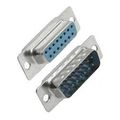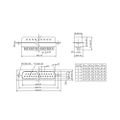DB15 connector: Difference between revisions
(Created page with "250px|right|"Male" and "Female" DB15 connectors A ''' DB15 connector''' (D-sub) or more correctly the '''DA-15''...") |
No edit summary |
||
| Line 6: | Line 6: | ||
However, this naming pattern is not always followed. Because personal computers first used DB-25 connectors for their [[Wikipedia: Serial port | serial]] and [[Wikipedia: Parallel port | parallel]] ports, when the PC serial port began to use 9-pin connectors, they were often labeled as DB-9 instead of DE-9 connectors, due to an ignorance of the fact that B represented a shell size. It is now common to see DE-9 connectors sold as DB-9 connectors. DB-9 nearly always refers to a 9-pin connector with an E size shell. | However, this naming pattern is not always followed. Because personal computers first used DB-25 connectors for their [[Wikipedia: Serial port | serial]] and [[Wikipedia: Parallel port | parallel]] ports, when the PC serial port began to use 9-pin connectors, they were often labeled as DB-9 instead of DE-9 connectors, due to an ignorance of the fact that B represented a shell size. It is now common to see DE-9 connectors sold as DB-9 connectors. DB-9 nearly always refers to a 9-pin connector with an E size shell. | ||
The | The DB15 connector can be found on Tektronix products like the [[2782]] and [[2784]]. | ||
<gallery> | <gallery> | ||
Revision as of 22:22, 27 June 2019

A DB15 connector (D-sub) or more correctly the DA-15 connector contains two or more parallel rows of pins or sockets usually surrounded by a D-shaped metal shield that provides mechanical support, ensures correct orientation, and may screen against electromagnetic interference. The part containing pin contacts is called the male connector or plug, while that containing socket contacts is called the female connector or socket.
The D-sub series of connectors was introduced by Cannon in 1952. Cannon's part-numbering system uses D as the prefix for the whole series, followed by one of A, B, C, D, or E denoting the shell size, followed by the number of pins or sockets, followed by either P (plug or pins) or S (socket) denoting the gender of the part. Each shell size usually (see below for exceptions) corresponds to a certain number of pins or sockets: A with 15, B with 25, C with 37, D with 50, and E with 9. For example, DB-25 denotes a D-sub with a 25-position shell size and a 25-position contact configuration.
However, this naming pattern is not always followed. Because personal computers first used DB-25 connectors for their serial and parallel ports, when the PC serial port began to use 9-pin connectors, they were often labeled as DB-9 instead of DE-9 connectors, due to an ignorance of the fact that B represented a shell size. It is now common to see DE-9 connectors sold as DB-9 connectors. DB-9 nearly always refers to a 9-pin connector with an E size shell.
The DB15 connector can be found on Tektronix products like the 2782 and 2784.
-
"Male" and "Female" DB15 Connectors
-
Mechanical drawing

